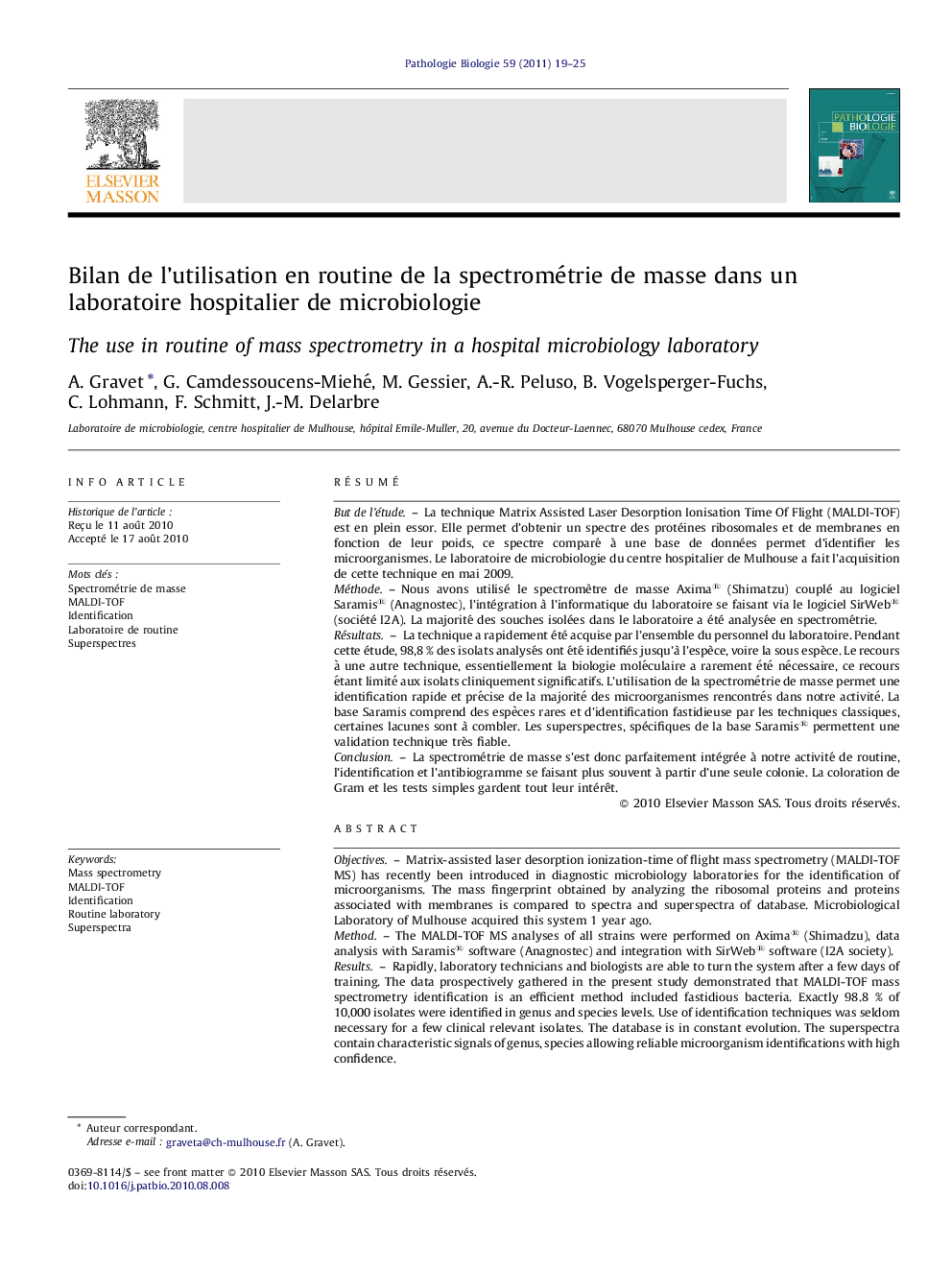| کد مقاله | کد نشریه | سال انتشار | مقاله انگلیسی | نسخه تمام متن |
|---|---|---|---|---|
| 4136260 | 1271905 | 2011 | 7 صفحه PDF | دانلود رایگان |

RésuméBut de l’étudeLa technique Matrix Assisted Laser Desorption Ionisation Time Of Flight (MALDI-TOF) est en plein essor. Elle permet d’obtenir un spectre des protéines ribosomales et de membranes en fonction de leur poids, ce spectre comparé à une base de données permet d’identifier les microorganismes. Le laboratoire de microbiologie du centre hospitalier de Mulhouse a fait l’acquisition de cette technique en mai 2009.MéthodeNous avons utilisé le spectromètre de masse Axima® (Shimatzu) couplé au logiciel Saramis® (Anagnostec), l’intégration à l’informatique du laboratoire se faisant via le logiciel SirWeb® (société I2A). La majorité des souches isolées dans le laboratoire a été analysée en spectrométrie.RésultatsLa technique a rapidement été acquise par l’ensemble du personnel du laboratoire. Pendant cette étude, 98,8 % des isolats analysés ont été identifiés jusqu’à l’espèce, voire la sous espèce. Le recours à une autre technique, essentiellement la biologie moléculaire a rarement été nécessaire, ce recours étant limité aux isolats cliniquement significatifs. L’utilisation de la spectrométrie de masse permet une identification rapide et précise de la majorité des microorganismes rencontrés dans notre activité. La base Saramis comprend des espèces rares et d’identification fastidieuse par les techniques classiques, certaines lacunes sont à combler. Les superspectres, spécifiques de la base Saramis® permettent une validation technique très fiable.ConclusionLa spectrométrie de masse s’est donc parfaitement intégrée à notre activité de routine, l’identification et l’antibiogramme se faisant plus souvent à partir d’une seule colonie. La coloration de Gram et les tests simples gardent tout leur intérêt.
ObjectivesMatrix-assisted laser desorption ionization-time of flight mass spectrometry (MALDI-TOF MS) has recently been introduced in diagnostic microbiology laboratories for the identification of microorganisms. The mass fingerprint obtained by analyzing the ribosomal proteins and proteins associated with membranes is compared to spectra and superspectra of database. Microbiological Laboratory of Mulhouse acquired this system 1 year ago.MethodThe MALDI-TOF MS analyses of all strains were performed on Axima® (Shimadzu), data analysis with Saramis® software (Anagnostec) and integration with SirWeb® software (I2A society).ResultsRapidly, laboratory technicians and biologists are able to turn the system after a few days of training. The data prospectively gathered in the present study demonstrated that MALDI-TOF mass spectrometry identification is an efficient method included fastidious bacteria. Exactly 98.8 % of 10,000 isolates were identified in genus and species levels. Use of identification techniques was seldom necessary for a few clinical relevant isolates. The database is in constant evolution. The superspectra contain characteristic signals of genus, species allowing reliable microorganism identifications with high confidence.ConclusionIn conclusion, our results show that MALDI-TOF MS is a fast and reliable technique for identification of most bacterial strains routinely isolated in a clinical microbiology. Identification and susceptibility testing with a single cell colony are more often possible. The simple tests, such as Gram staining and oxidase and catalase tests are usually performed in our laboratory.
Journal: Pathologie Biologie - Volume 59, Issue 1, February 2011, Pages 19–25